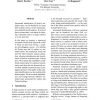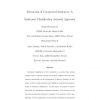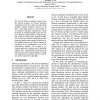COLING
2010
14 years 15 days ago
2010
This paper presents a novel semisupervised learning algorithm called Active Deep Networks (ADN), to address the semi-supervised sentiment classification problem with active learni...
COLING
2010
14 years 15 days ago
2010
Automated identification of diverse sentiment types can be beneficial for many NLP systems such as review summarization and public media analysis. In some of these systems there i...
COLING
2010
14 years 15 days ago
2010
Polarity shifting marked by various linguistic structures has been a challenge to automatic sentiment classification. In this paper, we propose a machine learning approach to inco...
IDA
2010
Springer
14 years 2 months ago
2010
Springer
Sentiment classification in text documents is an active data mining research topic in opinion retrieval and analysis. Different from previous studies concentrating on the developm...
ACL
2009
14 years 3 months ago
2009
The lack of Chinese sentiment corpora limits the research progress on Chinese sentiment classification. However, there are many freely available English sentiment corpora on the W...
NAACL
2010
14 years 3 months ago
2010
In this paper, we present a dependency treebased method for sentiment classification of Japanese and English subjective sentences using conditional random fields with hidden varia...
ACL
2010
14 years 3 months ago
2010
In this paper, we adopt two views, personal and impersonal views, and systematically employ them in both supervised and semi-supervised sentiment classification. Here, personal vi...
CORR
2002
Springer
14 years 5 months ago
2002
Springer
We consider the problem of classifying documents not by topic, but by overall sentiment, e.g., determining whether a review is positive or negative. Using movie reviews as data, w...
WWW
2010
ACM
14 years 5 months ago
2010
ACM
Sentiment classification aims to automatically predict sentiment polarity (e.g., positive or negative) of users publishing sentiment data (e.g., reviews, blogs). Although traditio...
ACL
2004
14 years 7 months ago
2004
Sentiment classification is the task of labeling a review document according to the polarity of its prevailing opinion (favorable or unfavorable). In approaching this problem, a m...



